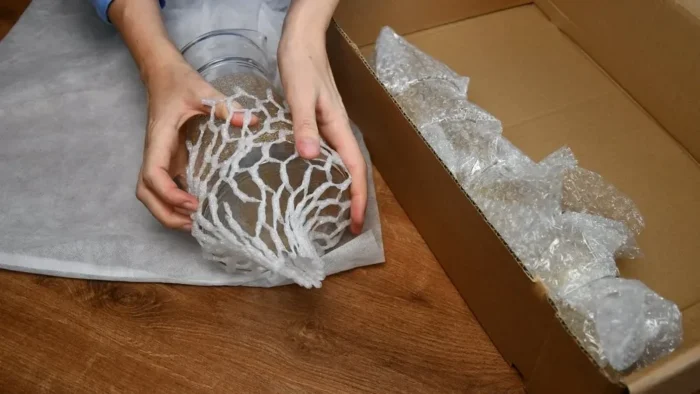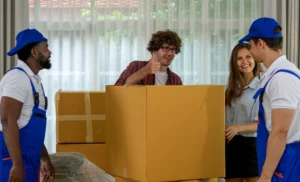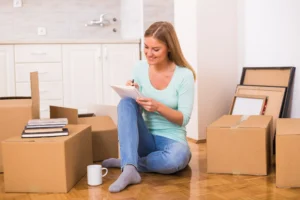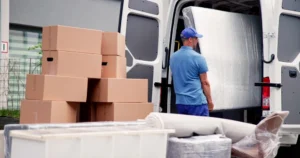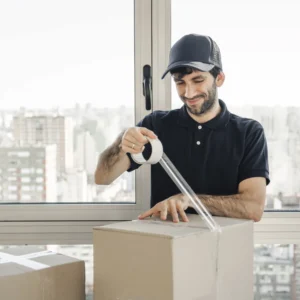Moving day brings stress, but nothing compares to the worry of unpacking broken dishes or shattered heirlooms. Whether you’re relocating across town or across the country, knowing how to pack fragile items for moving can save you heartache and money. The good news? With the right materials and techniques, you can protect even your most delicate belongings.
This guide walks you through proven packing strategies used by professional movers. You’ll learn which supplies work best, how to wrap different items, and common mistakes to avoid. By the end, you’ll pack like a pro and move with confidence.
Essential Packing Materials You’ll Need
The foundation of packing fragile items for moving starts with quality supplies. Don’t cut corners here. Cheap materials lead to expensive replacements.
Boxes: Use small to medium boxes for heavy fragile items. Large boxes become too heavy and hard to handle. Look for double-walled cardboard boxes. Avoid boxes with tears, dents, or water damage.
Bubble wrap: This protective wrapping comes in different bubble sizes. Use small bubbles for delicate items like wine glasses. Large bubbles work better for vases and picture frames. Buy at least two rolls for an average home.
Packing paper: Clean newsprint or kraft paper protects items without leaving ink marks. You’ll need about 25 pounds of paper for a typical kitchen. Regular newspaper works in a pinch but can stain white china and ceramics.
Packing peanuts: These foam pieces fill empty spaces and prevent items from shifting. They’re messy but effective. Biodegradable options are now available if you’re eco-conscious.
Packing tape: Use quality tape that’s at least 2 inches wide. Plan on one roll per 10 boxes. Consider using red or orange tape for fragile boxes so they stand out.
Cardboard dividers: These create individual compartments for glasses and stemware. You can buy them or make your own from extra cardboard boxes.
You may read How To Pack Tv For Moving Without Box?
10 Essential Packing Tips for Fragile Items for Moving
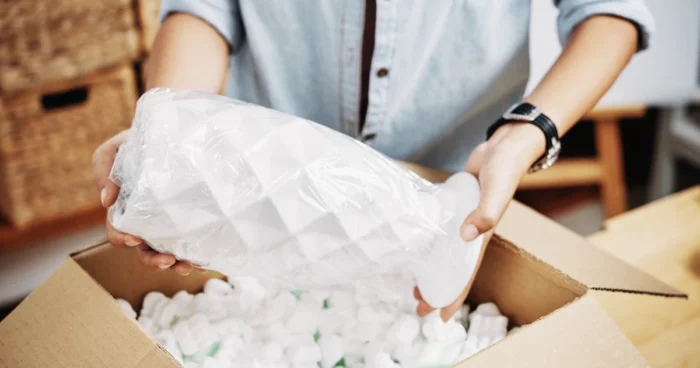
Professional movers follow specific steps for a reason: they work. These core rules ensure that your items stay put and protected throughout the move, setting the standard for expert-level packing fragile items for moving.
1. Build a Triple-Layer Base Cushion
A secure box base is the first line of defense. Start by sealing the bottom of your box with three strips of packing tape. Next, lay a piece of cardboard on the bottom for stability. Finally, create a two-inch layer of crumpled packing paper or bubble wrap to act as a shock absorber.
2. Wrap Every Item Individually and Securely
Do not allow fragile items to touch each other, as this is the primary cause of damage in transit. Wrap each item fully in packing paper. For items with odd shapes or handles, use a second layer of paper. Secure the wrapping with a small piece of tape so the paper stays tight around the object.
3. Reinforce Hollow Objects from the Inside
Hollow items like vases, cups, or delicate bowls are prone to cracking when pressure is applied to their exterior. Gently stuff the inside of each hollow item with crumpled packing paper before wrapping the outside. This internal support significantly reinforces the structure.
4. Pack Flatware and Plates Vertically
A common mistake is stacking plates flat, which transfers the weight of the entire stack to the bottom plate. Instead, wrap each plate individually, then place them standing on their edges, like books on a shelf. Pad heavily between each wrapped plate with a folded piece of paper for lateral support.
5. Master the Art of Glassware and Stemware
For wine glasses and other stemware, wrap the stem first, as it is the weakest point. Next, stuff the cup portion. Finally, wrap the entire piece with bubble wrap and secure it with tape. Place all glassware in a box that utilizes cell dividers for total separation.
6. Use the Right Cushioning to Eliminate Movement
Once all items are safely packed inside, fill any remaining empty space in the box with crumpled paper or soft materials until the box is firm. Gently shake the box; if you hear or feel movement, add more filler. The box must be completely full so the contents cannot shift during transport.
7. Distribute Weight from Bottom to Top
When loading any box, the heaviest items must always go on the bottom. Place your heaviest, most durable breakables first, then layer up to the lightest and most delicate pieces. This technique ensures the box remains stable and prevents lighter things from being crushed under weight.
8. Clearly Label and Mark “This Side Up”
Use a permanent marker to label the box “FRAGILE” on all four sides and the top. Crucially, draw arrows pointing up, indicating the correct orientation for stacking and transport. This simple visual guide alerts everyone to handle the box with extra care.
9. Transport High-Value Items Separately
For truly irreplaceable or high-value items, such as unique art, jewelry, or sensitive family heirlooms, consider transporting them yourself in your vehicle. This gives you direct control and minimizes their time spent on the moving truck.
10. Avoid Overfilling or Underfilling Boxes
A box that is too heavy is a risk, but a box that is not full enough allows shifting. Aim for the “just right” principle: the box should be heavy enough to feel substantial but light enough for one person to lift easily. The contents must be snug and immobile.
Expertise in Specialty Fragile Items
Our experience at Chamomile Go as a premier Sherman Oaks Moving Company has shown that certain items require tailored methods. Our expertise in providing the best packaging for fragile items is based on these specific techniques.
How to Pack Mirrors and Wall Art
Large, flat items like mirrors and framed artwork are high-risk.
- Secure the Glass: Use painter’s tape to place a large “X” across the glass or mirror surface. If the glass shatters, the tape helps hold the pieces together.
- Corner Protection: Cut pieces of cardboard or foam to cover and reinforce all four corners.
- Final Wrap: Wrap the entire item in a generous layer of bubble wrap, followed by a thick furniture blanket or specialty paper padding. Always label it clearly as “GLASS” and transport it standing upright.
Packing Lamps and Shades Safely
Lamps are complex and require disassembly.
- Disassemble: Remove the bulb, harp (the wire frame holding the shade), and shade from the base.
- Wrap Components: Wrap the base securely in bubble wrap. Wrap the harp and bulb separately in packing paper.
- Shades: Lamp shades must be packed in their own box. Do not stuff shades with paper, as this can easily crease or damage them. Only put other soft, light items like pillows or blankets in the same box.
Electronics and Computer Equipment
While not always fragile in the breakable sense, electronics are highly sensitive. Use anti-static bubble wrap and ensure cords are neatly bundled and placed in a small plastic bag taped to the device itself. This prevents scratching and makes reassembly simple.
Conclusion
Successfully mastering how to pack fragile items for moving takes time and meticulous care. If you find yourself overwhelmed by the volume of delicate items or simply want a guaranteed result, professional packing is the ideal solution.
At Chamomile Go, our dedicated team offers comprehensive packing services throughout the Los Angeles area. Our Sherman Oaks Moving Company utilizes professional-grade packaging for fragile items and proven techniques to ensure everything from fine china to valuable collectibles is fully protected. Call us today for a free estimate and choose peace of mind for
FAQs
What size boxes should I use for fragile items?
Small to medium boxes work best for packaging for fragile items. Small boxes are ideal for dishes, glasses, and books. Medium boxes work for lamps, small electronics, and decorative items. Large boxes become too heavy when filled with fragile items.
Can I use newspaper instead of packing paper?
Newspaper works in a pinch but isn’t ideal. Newsprint ink can transfer to white dishes, porcelain, and other light-colored items. If you must use newspaper, wrap items first in white tissue paper. Regular packing paper is inexpensive and worth the investment.
How much bubble wrap do I need?
Plan on 2 rolls of bubble wrap for every room containing fragile items. A typical kitchen needs 3-4 rolls. Living rooms and home offices need 1-2 rolls each. Buy more than you think you’ll need.
Should I pack plates flat or standing up?
Pack plates standing on their edges, like records in a crate. This vertical position distributes weight more evenly and reduces breakage compared to stacking plates flat.
How do I pack wine glasses safely?
Fill the inside of each glass with crumpled packing paper. Wrap the stem separately with bubble wrap, then wrap the entire glass. Use cardboard dividers in boxes to keep glasses separated.
